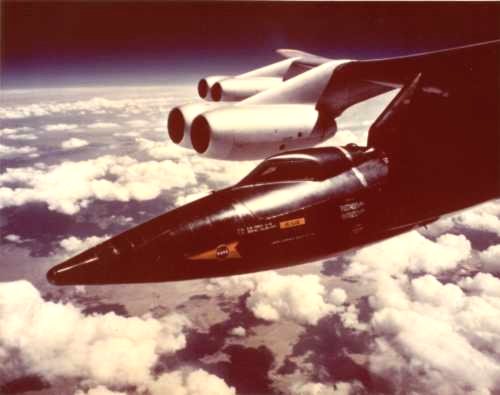

You, the pilot, arrive at the Base while others are finishing final
fueling and system checks in the hours approaching dawn. 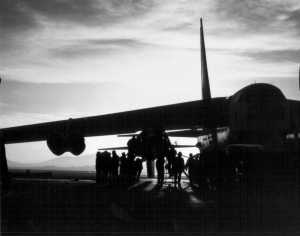
You'll start with the X-15 already hanging from a pylon on the B-52
carrier aircraft. Don't bother with a nitty gritty total hardware
preflight; the taxpayers
thoughtfully provided a whole staff to do it for you. Anyway, you're
cooped
up in a pressure suit, prebreathing 100% oxygen.
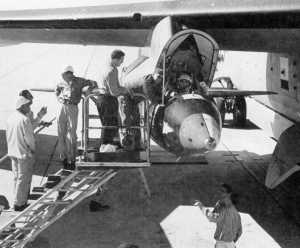
After entering the cockpit, strap in and and run through the interior
check. That's 120 checklist items, ending with "close canopy". By now
the B-52 is supplying power, breathing oxygen, nitrogen, and liquid
oxygen to top off loss from the oxidizer tank.
That LOX loss is due in part to precooling the engine, which you initiate in the captive takeoff checklist. While precooling, LOX flows through almost all of its usual path to the engine, then dumps overboard at the liquid oxygen prime valve. You'll precool for 10 minutes, then start a schedule of 20 minutes off and 7 1/2 minutes on.
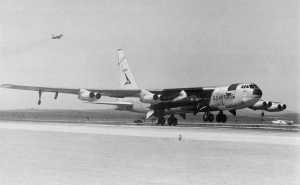 Takeoff isn't just
you and the B-52. Typical missions will add three chase planes,
rescue helicopters, a C-130, and an array of ground vehicles deploying
to places between your planned takeoff location and Edwards. Some
of this force goes to dry lakes that might be needed for emergency
landings along the planned route of your flight.
Takeoff isn't just
you and the B-52. Typical missions will add three chase planes,
rescue helicopters, a C-130, and an array of ground vehicles deploying
to places between your planned takeoff location and Edwards. Some
of this force goes to dry lakes that might be needed for emergency
landings along the planned route of your flight.
A few things will need heat during the climb, so be sure to turn on the heaters for the windshield, your face mask, and the nose ballistic rockets (the X-15's nose, not yours). Also ask the B-52 crew about the hook heater.
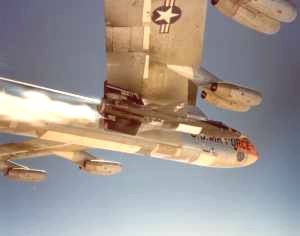 Once at
altitude, go through the 27-item prelaunch checklist. Among
other things, you'll switch to the X-15's breathing oxygen, shut off
liquid
nitrogen but not gaseous nitrogen from the B-52, and start the APU's.
Once at
altitude, go through the 27-item prelaunch checklist. Among
other things, you'll switch to the X-15's breathing oxygen, shut off
liquid
nitrogen but not gaseous nitrogen from the B-52, and start the APU's.
Next comes the 29-item precountdown checklist. Among other things, you will:
They're serious about that 30 second time limit for either lighting up or shutting down. When there's 7 seconds more of idle time allowed, an IDLE END caution light comes on. When time runs out, a NO DROP light tells you to shut it down.
So... when you get through the brief countdown and you drop, don't waste much time before moving the throttle from OFF to at least 50%. That'll light the main chamber, giving you the second part of a big one-two punch.
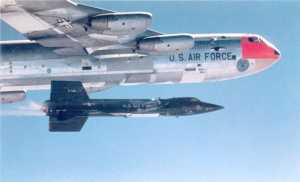 Part 1 was the drop itself.
Starting to fall may sound like a gentle and mellow start, but it can
feel more like being catapulted straight down. In the early flights
even a short countdown wasn't adequate preparation when the B-52 crew
initiated the drop -- NASA soon rerigged the system so that it would be
the X-15 pilot who tripped the release, giving you at least a feeling
of being just a bit more ready for the event.
Part 1 was the drop itself.
Starting to fall may sound like a gentle and mellow start, but it can
feel more like being catapulted straight down. In the early flights
even a short countdown wasn't adequate preparation when the B-52 crew
initiated the drop -- NASA soon rerigged the system so that it would be
the X-15 pilot who tripped the release, giving you at least a feeling
of being just a bit more ready for the event.
This pilot report is split into these four parts:
1. X-15 General
Description & Walkaround
2. X-15 Cockpit Check
3. X-15
Flight:
Heading Out to Launch
4. X-15
Flight:
Flying the Mission and Returning
Related to all four sections:
Photo credits
and pointers to related resources
..